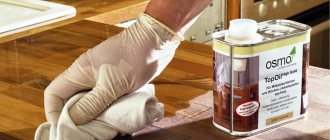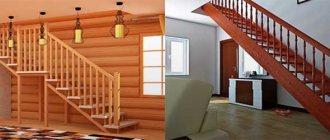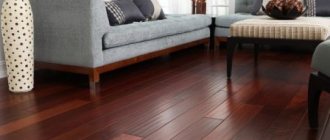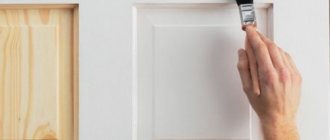In order to update the decorative finish on a particular surface, it is necessary to properly prepare the working base. So, before painting using technology, the old coating must be removed. Let's look at the features of three methods that allow us to solve this problem: mechanical and thermal effects on the surface, removing varnish from wood. Let's get acquainted with the features of each technique and recommendations from experts.
Example of varnish removal Source allegroimg.com
Technical features of the event
Almost all types of varnishes form a film. The compositions differ in the principle of action and in the thickness of the coating formed. Therefore, there is no universal way to remove it.
The choice of solution for how to remove varnish from a wooden surface depends on the following criteria:
- density and coating layer;
- chemical composition of the finish;
- the nature of the working foundation.
The last point is especially important. To work with fabrics, glass or parquet, you need to use different techniques. Let's take a closer look at each of them.
How to remove acrylic varnish
Acrylic varnish forms a beautiful matte or glossy film on wood. If you want to refinish the floors, the acrylic varnish will need to be removed. The fact is that over time, the old varnish will begin to swell and move away from the freshly treated surface. Consequently, the top coating will peel off in ugly pieces.
- The mechanical method is excellent for removing acrylic varnish. In general, this is an almost universal option, as it has a gentle effect on the tree.
- When heated, the acrylic composition is also easily removed. It begins to crack and shrink, all that remains is to lightly pry it with an old chisel or spatula.
- When choosing a chemical, make sure that it is suitable specifically for acrylic-based varnish.
Description of various methods
Removing the varnish coating involves direct action on the film. This may be mechanical force, the use of chemically active compounds or thermal pressure. Each option has its own characteristics.
Mechanical impact
The easiest way to remove varnish from wood or other surfaces is to peel off the film by physical force. To do this, use a tool with stiff bristles or a metal blade.
Manual scraper for mechanical removal of paintwork materials Source vseinstrumenti.ru
Thin-layer coatings can also be abraded with varying degrees of grit abrasive. As an alternative to ready-made devices, blades, knives, and glass can be used. The latter, however, wears off very quickly. In any case, you need to protect your hands from cuts.
In addition to hand tools, there are analogs for use with electrical equipment. Thus, an analogue of a cord brush are attachments with metal bristles, which can be installed in a chuck for a drill and screwdriver. With an angle grinder, flap discs with bristles along the edge and emery or grinding wheels are used. The latter are fixed on a special platform called a plate.
Another solution to removing varnish from a wooden surface is a specialized tool. This is a sanding machine. There are three types:
- vibration - a rectangular platform with a small amplitude makes reciprocating movements in the longitudinal direction;
Vibrating grinder Source gidpokraske.ru
- tape - here the sandpaper is represented by a closed narrow strip, which the mechanism rotates in one direction in a straight line relative to the tool;
- eccentric - the mechanism transmits translational and reciprocating circular movements to the platform.
The high efficiency of each of the tools is the main advantage. But during the grinding and polishing process, a large amount of dust is generated. This problem can only be solved with models that can function in conjunction with a vacuum cleaner. Practice shows that a simple dust collector slightly improves the situation.
The listed solutions have both advantages and disadvantages. On the one hand, there is no need to breathe toxic substances, there is no risk of changing the color of the working base, and you can control the entire process. But on the other hand, in addition to the dust generated, there is a risk of mechanical damage to the wood structure, fabric fibers and scratches on a smooth surface.
See also: Catalog of companies that specialize in finishing materials and related work
Chemical removal
A wide range of products are available on the construction market for removing varnish from wooden surfaces.
Special remover for old paint and varnish Source voil.ru
These can be liquid removers, gel-like compositions, solvents and powders. Let's look at the features of each of them:
- Liquid . The product is used provided that the coating consists of a maximum of three layers. This is justified by the fact that such varnish remover contains solvents that evaporate quickly. That is, chemical reagents can affect the coating for an extremely short period of time. Also, due to the consistency, there is a limitation in the form of vertical bases. Here the wash just runs off.
- Gel and paste . Such compositions can have a chemical effect on the base for a long time. Therefore, they are relevant for removing multi-layer coatings, including vertical ones.
- Powder . This option is more often used in the case of large-scale work, which is justified by convenience and long shelf life. Before use, the material must be dissolved in water to obtain a thick paste-like mass.
Removing coating after chemical exposure Source sdelai-lestnicu.ru
Solvent can also be considered one of the means for removing varnish from wooden surfaces. But here it is important to take into account the fact that the composition is capable of chemically acting on the coating only until it has dried. A spray works a little better, which turns into foam at the exit. This mass is not as fluid as liquids. But the action time is inferior to gels and pastes.
Thermal impact
A relatively universal solution for how to clean varnish from a wooden surface can be considered thermal action. By heating the base, the bond between it and the coating weakens. The film first cracks, then softens. Therefore, it can be easily removed with a regular spatula.
Purchased processing products
We need to figure out how severe the initial destruction of the material is and what tools will be easier to do the job.
Powder materials in this regard are considered the most professional solution, although paste is also pleasing with the result. They are the ones who can easily remove up to ten layers of varnish. It will be enough to dilute the composition with water until a paste-like substance is formed. It is simply applied with a brush to the surface where the old varnish was. The work of removing old varnish from old furniture should be done evenly, without repetition.
Ready-made liquids or gels do not require dilution with water. Such compositions are immediately ready for application using a brush. But these products only remove up to three layers.
The most convenient means for old varnish is a spray, but in terms of effectiveness it will lose to its analogues.
After applying any of the products, the surface is covered with a film. Then they leave it like that for a while. The coating material is removed when the color becomes dark and the varnish itself becomes viscous. The old coating is simply removed from the wood with a spatula. The main thing is to remember that varnished surfaces require special care in the future.
How best to remove old varnish (2 videos)
Nail polish removal methods (22 photos)
Operating Instructions
When choosing what and how to remove varnish from wood, you need to familiarize yourself with the rules of the event in advance. This way the process will be completed with the highest quality possible and without harm to human health. Let's consider the instructions and recommendations of specialists regarding each of the techniques.
Cord brush attachment for a screwdriver Source onlinetrade.ru
Mechanical removal technology
The first thing to do is determine the thickness of the coating layer to be removed. This can be all of the varnish or just part of it. The second option is provided by the base preparation technology if subsequent varnishing with a material similar in characteristics is planned.
Next, select a tool. It is easier to remove the top layers with coarse cord brushes and coarse-grain abrasives. To prevent damage to the base, you need to gradually reduce the degree of aggressiveness of the physical impact. The process is completed by sanding the working area with fine-grained sandpaper. After removing dust and dirt, you can begin further finishing work.
Chemical Removal Technology
The process of removing varnish from wood consists of several stages. But before this, it is important to protect surrounding objects, hands, respiratory organs and eyes from chemical exposure.
Working with chemical compounds in rubber gloves Source berkem.ru
Tools and materials
Before carrying out restoration work, you need to prepare tools and protective equipment:
- Sandpaper;
- Sander;
- Construction hair dryer;
- Putty knife;
- Brush;
- Wire brush;
- Blowtorch;
- Foam sponge;
- Cellophane film;
- Wash;
- Protective glasses;
- Latex gloves;
- Respirator.
Tip: “Professionals recommend using a spatula without sharp edges. On new instruments, the metal plane has sharp corners. You can round them with a file or grinder. Otherwise, the restored coating will be damaged. A plastic tool would be ideal.”
How to cover the lining at the dacha. How to choose a color?
It is very important to choose the right color that will prevail indoors.
This also applies to the color of the future lining. The main thing is to remember that there should not be strong contrasts indoors. If clapboard panels are made inside the house, then the walls, floor and ceiling should differ in color or shade. If the walls are painted the same color and shade as the lining, then all the beauty of the wood will merge with the walls, and you may simply not notice it.
If in a country house the walls of the kitchen or living room are covered with clapboard, then the ideal covering for such walls would be a range of warm shades. Experts recommend paying attention to peach, pistachio, brown or beige colors.
To paint the lining in the bedroom, shades of pink, honey or the color of baked milk are recommended. In a children's room, the colors should be bright and saturated, but scarlet, black, rich blue and purple should be taken very seriously and not overload the space of the room with them, since they are irritating to the eyes.
If there is a study in the house, then gray, green or blue colors are suitable for wall decoration. Be sure to have light-colored pieces of furniture or decor in the room, which can be used to dilute the strict color.
If your country house is very small in size, then you can visually enlarge it inside by covering the paneling with white. The room becomes not only larger, but also brighter, cleaner and more comfortable. Typically, white color is used only for ceilings, on which, if there are any defects, they are almost invisible.











